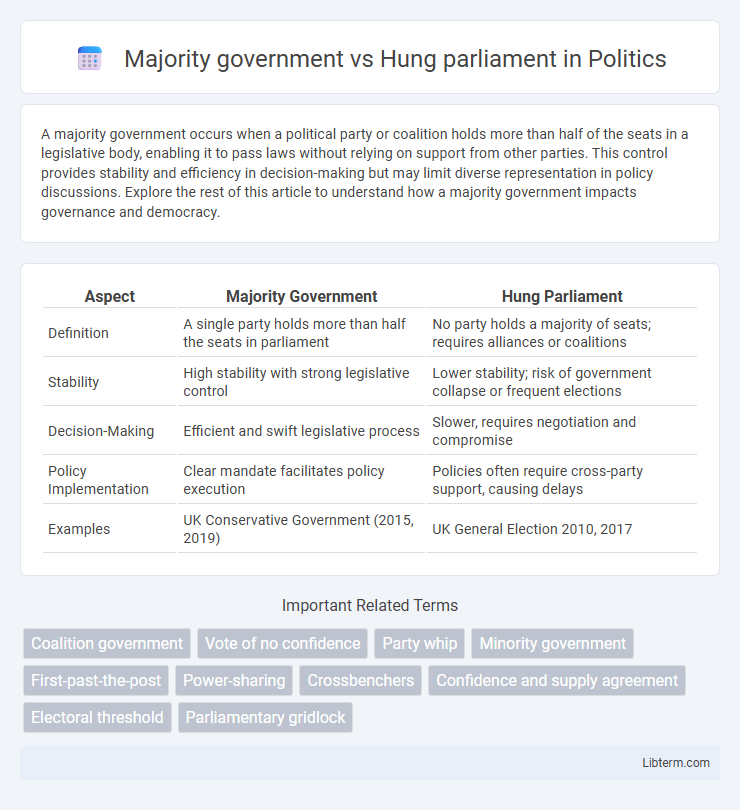A majority government occurs when a political party or coalition holds more than half of the seats in a legislative body, enabling it to pass laws without relying on support from other parties. This control provides stability and efficiency in decision-making but may limit diverse representation in policy discussions. Explore the rest of this article to understand how a majority government impacts governance and democracy.
Table of Comparison
| Aspect | Majority Government | Hung Parliament |
|---|---|---|
| Definition | A single party holds more than half the seats in parliament | No party holds a majority of seats; requires alliances or coalitions |
| Stability | High stability with strong legislative control | Lower stability; risk of government collapse or frequent elections |
| Decision-Making | Efficient and swift legislative process | Slower, requires negotiation and compromise |
| Policy Implementation | Clear mandate facilitates policy execution | Policies often require cross-party support, causing delays |
| Examples | UK Conservative Government (2015, 2019) | UK General Election 2010, 2017 |
Understanding Majority Governments
A majority government occurs when a single political party secures more than half of the seats in the legislature, enabling it to pass laws and implement policies without relying on support from other parties. This stable control facilitates efficient decision-making and consistent governance, reducing the likelihood of legislative deadlock. Understanding majority governments highlights their role in ensuring political stability and clear accountability within parliamentary systems.
Defining a Hung Parliament
A hung parliament occurs when no single political party wins an outright majority of seats in the legislature, leading to a situation where coalition-building or agreements with other parties become essential to form a government. This contrasts with a majority government, where one party secures more than half of the seats, allowing for smoother governance and policy implementation without needing support from opposition parties. Hung parliaments often result in negotiated compromises and can lead to political instability or delayed legislative processes.
Formation Process: Majority vs Hung Parliament
A majority government forms when a single party secures more than half the seats in the legislature, allowing it to pass legislation without relying on other parties. In contrast, a hung parliament occurs when no party achieves an outright majority, leading to coalition negotiations or confidence-and-supply agreements to establish a working government. The formation process in a hung parliament often involves complex bargaining, power-sharing arrangements, or minority governments supported externally by smaller parties.
Stability and Policy Implementation
A majority government ensures political stability by holding more than half the seats, facilitating smoother passage of legislation and consistent policy implementation. In contrast, a hung parliament, where no party has a clear majority, often leads to fragile coalitions or minority governments, resulting in compromised policies and slower decision-making. This instability can hinder effective governance and delay critical reforms.
Coalition Building in Hung Parliaments
Coalition building in hung parliaments involves multiple political parties negotiating to form a stable government when no single party wins an outright majority. This process requires compromise on policy agendas and power-sharing agreements to achieve a working majority in the legislature. Effective coalition building can lead to more inclusive governance but may also result in slower decision-making and reduced policy consistency compared to majority governments.
Governance Efficiency Compared
A majority government enables streamlined decision-making processes and swift policy implementation due to clear legislative control, reducing legislative gridlock. In contrast, a hung parliament often requires coalition-building or minority agreements, which can slow governance and complicate policy consensus. This fragmentation typically leads to less stable governments and challenges in passing legislation efficiently.
Impact on Legislative Decision-Making
Majority governments enable smoother legislative decision-making by securing consistent parliamentary support, allowing for efficient passage of laws and implementation of policies. Hung parliaments often result in fragmented votes, requiring coalition-building and compromises, which can delay legislation and introduce policy uncertainty. The stability of a majority government typically fosters decisive governance, whereas hung parliaments may lead to legislative gridlock and reduced governmental effectiveness.
Voter Representation and Accountability
Majority governments provide clearer voter representation by enabling elected officials to implement policies without reliance on coalition agreements, leading to more direct accountability as voters can attribute government actions to a single party. Hung parliaments, resulting from no party winning an outright majority, often require coalition-building that can dilute voter mandates and complicate accountability since policy decisions reflect compromises among multiple parties. Consequently, voter representation in hung parliaments may be more fragmented, and accountability more diffused, impacting the clarity of government responsibility.
Historical Examples and Outcomes
The United Kingdom's 2019 general election resulted in a Conservative majority government, enabling Prime Minister Boris Johnson to pass Brexit legislation swiftly. In contrast, the 2010 election produced a hung parliament, leading to a coalition government between Conservatives and Liberal Democrats, which resulted in significant policy compromises and austerity measures. Historical examples like the 1974 UK elections, which also resulted in hung parliaments, often lead to unstable administrations and early elections due to difficulty in forming lasting alliances.
Pros and Cons of Each System
A majority government ensures political stability and efficient decision-making by having more than half the seats in parliament, allowing smoother passage of legislation, though it may limit minority representation and reduce debate diversity. A hung parliament promotes coalition-building and wider representation of diverse viewpoints, enhancing democratic inclusiveness, but it often results in political uncertainty, slower legislative processes, and potential instability due to fragile alliances. The choice between majority government and hung parliament impacts governance efficiency, democratic representation, and political predictability within parliamentary systems.
Majority government Infographic

 libterm.com
libterm.com